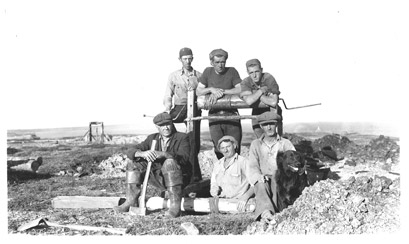The first commercial coal mine in N. America started 300 years ago in #PortMorien when, in 1720, the French started it to supply #FortressLouisbourg.
Here is part 2 of the history of mining around Port Morien:
#nspoli #cbpoli #capebreton #novascotia @Port_Morien @GeoffMacLellan

Here is part 2 of the history of mining around Port Morien:
#nspoli #cbpoli #capebreton #novascotia @Port_Morien @GeoffMacLellan


1886 - The Blockhouse site was seized by the sheriff and sold due to the company being in arrears in royalty payments. The mine was almost lost in March to due a break at surface near Hugh MacDonald brook.
#nspoli #cbpoli #capebreton #novascotia
#nspoli #cbpoli #capebreton #novascotia

In August 1886 the mine was sold to Mr. C. Belloni and production continued but the lower workings were permitted to flood.
1888 – Production ceased at the Blockhouse Colliery.
#nspoli #cbpoli #capebreton #novascotia
1888 – Production ceased at the Blockhouse Colliery.
#nspoli #cbpoli #capebreton #novascotia

1893 – The Gowrie Mine, main shaft at Morien Junction, was taken over by the Dominion Coal Company, which built a coal wash plant along the Sydney-Louisbourg railway, approximately 2-kilometres south of Morien Junction.
#nspoli #cbpoli #capebreton #novascotia
#nspoli #cbpoli #capebreton #novascotia

1897 – The Gowrie Mine was closed and it is believed the wash plant was as well.
1899 – A new sub-sea colliery was started by the Gowrie & Blockhouse Mining Company in the Gowrie Seam with the main shafts adjacent to the site of the present-day Port Morien Legion.
#nspoli #cbpoli
1899 – A new sub-sea colliery was started by the Gowrie & Blockhouse Mining Company in the Gowrie Seam with the main shafts adjacent to the site of the present-day Port Morien Legion.
#nspoli #cbpoli

1907 - North Atlantic Collieries Ltd., took over the sub-sea Gowrie Mine and started sinking a shaft on the shore at Long Beach with the intention of working both the Blockhouse and Gowrie seams offshore.
#nspoli #cbpoli #capebreton #novascotia
#nspoli #cbpoli #capebreton #novascotia

1910 – The Dominion Coal Company opened the No. 21 Colliery by driving two slopes to the South from the outcrop at Tower Road. Ultimately the slopes extended to the outcrop on the road to John Allen Lake.
#nspoli #cbpoli #capebreton #novascotia
#nspoli #cbpoli #capebreton #novascotia

1912 – The sub-sea Gowrie seam workings extended almost 3 kilometres out under Morien Bay when production ceased.
The Dominion Coal Company initiated construction of the Dominion No. 22 Slopes at the East end of Birch Grove.
#nspoli #cbpoli #capebreton #novascotia
The Dominion Coal Company initiated construction of the Dominion No. 22 Slopes at the East end of Birch Grove.
#nspoli #cbpoli #capebreton #novascotia

1920 – The Hiawatha Coal Company re-opened the Mira Bay Colliery at Waddens Cove, but it closes after only 6-months.
1922 – Dominion Coal’s No. 22 Colliery and the No. 21 continued mining but both had water issues associated with ground water seepage due to surface subsidence.
1922 – Dominion Coal’s No. 22 Colliery and the No. 21 continued mining but both had water issues associated with ground water seepage due to surface subsidence.

1925 – Dominion Coal’s No. 21 Colliery was closed.
1926 – The easterly extent of the No. 21 Colliery was connected to the old Gowrie Colliery by a level driven through a fault. Again, water problems due to surface subsidence plagued operations.
#nspoli #cbpoli #capebreton
1926 – The easterly extent of the No. 21 Colliery was connected to the old Gowrie Colliery by a level driven through a fault. Again, water problems due to surface subsidence plagued operations.
#nspoli #cbpoli #capebreton

1928 – A slope was sunk just north of the Gowrie mine dump on the Spencer Seam. The slope reached a depth of 200 feet before being abandoned due to what was considered inferior coal.
#nspoli #cbpoli #capebreton #novascotia
#nspoli #cbpoli #capebreton #novascotia

Also in 1928, a test shaft was sunk on the same seam, approximately 2 kilometres to the West, near the present-day sewage treatment facility, but no development was initiated due to what was deemed inferior coal.
1930 – The No. 22 Colliery was closed.
#nspoli #cbpoli #capebreton
1930 – The No. 22 Colliery was closed.
#nspoli #cbpoli #capebreton

1956 – 800 tons was reclaimed from coal fines along the shoreline about 1 kilometre south of Port Morien Beach.
#nspoli #cbpoli #capebreton #novascotia
#nspoli #cbpoli #capebreton #novascotia

The work is conducted by the Crystal Coal Company and the fines were conveyed, via a sluice and stream, to the shore during the operation of the old Gowrie wash plant dump, approximately 1 kilometre to the west.
#nspoli #cbpoli #capebreton #novascotia
#nspoli #cbpoli #capebreton #novascotia

1962 – Operations of the Crystal Coal Company ceased. Over the course of the 7-year reclamation project, 16,000+ tons of coal were recovered.
1967 – The Wadden Cove Coal Company re-opened the old Mira Bay Colliery but abandoned the operation in the same year.
#nspoli #cbpoli
1967 – The Wadden Cove Coal Company re-opened the old Mira Bay Colliery but abandoned the operation in the same year.
#nspoli #cbpoli

Coal still provides over half of Nova Scotia's power. Mining it here creates jobs, government revenues to help pay for health and education, and keeps power bills down because local coal is cheaper than imported.
#nspoli #cbpoli #capebreton #novascotia
#nspoli #cbpoli #capebreton #novascotia

Thanks to the excellent staff @NS_Energy_Mines for their help with this history.
#nspoli #cbpoli #capebreton #novascotia
#nspoli #cbpoli #capebreton #novascotia

• • •
Missing some Tweet in this thread? You can try to
force a refresh



























